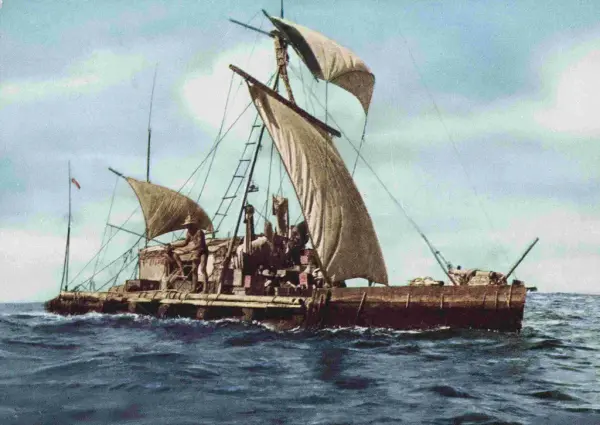- 1/1
From the Kon-Tiki expedition, 1947 Nasjonalbiblioteket
Polynesia (1937-38) and North West America (1939-40)
His first expedition was with his wife, Liv, to the island of Fatu Hiva in the Marquesas Archipelago in Polynesia, in 1937-1938. The aim of the expedition was to leave civilisation behind and live in complete harmony with nature. Before they left they did not intend to come back. However, the idyll and idealism was overshadowed by the reality of a tropical climate and illness, and after a year they returned to Norway. From 1939-1940 Heyerdahl lived among the Kwakiutl Indians in British Columbia.
Thor Heyerdahl noticed that the vegetation, winds and ocean currents indicated that Polynesia could have been populated from South America rather than Asia. Local oral tradition implied the same thing. After these expeditions, he expanded on this theory in the book «American Indians in the Pacific».
The Kon-Tiki Expedition (1947)
The academic establishment did not accept this theory, and the Kon-Tiki expedition was undertaken in order to prove that it was possible. On 28 April 1947, Heyerdahl and five crew members set sail near Callao in Peru on a traditional balsawood raft. After 101 days they reached the island of Raroia in the Tuamoto Archipelago.
The book about the expedition was translated into almost 70 different languages and became a bestseller. Heyerdahl’s film about the expedition won an Oscar for best documentary in 1951, and until 2007 it was the only Norwegian film to have won an Oscar.
Expeditions to Galapagos (1952) and Easter Island (1955-56)
Despite the success of the Kon-Tiki Expedition, scientists were not convinced. This started to change when Heyerdahl found traces of ancient South American cultures on Galápagos, where Heyerdahl’s group of archaeologists were able to identify objects from pre-Inca times. Heyerdahl also found traces of early settlements on Easter Island. Carbon dating of the finds showed that people had lived there as early as 380 AD, and during the excavations stone carvings were found that appeared to resemble ancient traditions in Peru.
The expedition to Easter Island resulted in the book Aku-Aku: The Secret of Easter Island (1957). The academic establishment, however, was not particularly enthusiastic about the book. The book reviewer in American Anthropologist described the book as a fairy tale trying to present itself as academic literature. Marian W. Smith in The Geographical Journal wrote that Heyerdahl’s findings were interesting, but that one should be extremely sceptical to his theories.
In the late 1990s, DNA tests found that Polynesians have more similarities with people from South East Asia than with people from South America, indicating that their ancestors most likely came from Asia.
Expeditions with Ra (1969) and Ra II (1970)
With Ra (1969) and Ra II (1970), Heyerdahl attempted to connect the South American Indians with the ancient civilizations of Africa and the Middle East. The Ra ships were reed boats built after ancient Egyptian paintings. The first one broke up just off the coast of Barbados in the Caribbean due to a construction defect. Ra II arrived safely in Barbados after a 57-day crossing from Safi in Morocco.
The Tigris Expedition (1977)
Heyerdahl wanted to try out his theories on trans-oceanic contact between pre-historic civilisations. In order to do this he had to build reconstructions of boats from Antiquity. In 1977 he built a new boat that he called Tigris. He and his crew sailed around in the Persian Gulf and Indian Ocean for five months with the aim of showing that Mesopotamia, the Indus culture and Egypt could have had trans-oceanic trading links as early as in the year 3000 BC. Tigris sailed under the UN flag but had major problems following its planned route because of all the wars in the area. In protest against the wars, Heyerdahl burnt the boat outside the harbour in Djibouti.
